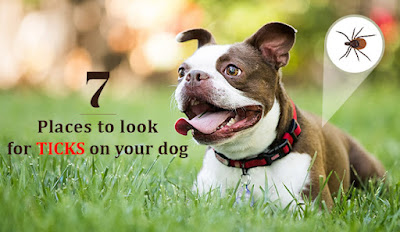Finding Ticks on Your Dog:
Ticks are annoying bloodsucking parasites that can not only find themselves a permanent home on your dog’s body but can also transmit deadly diseases.
Lyme disease, Rocky Mountain spotted fever, Canine Anaplasmosis (tick fever), Ehrlichiosis and Bartonellosis are a few such intractable tick-borne diseases.
Since ticks are a problem for dogs in Australia throughout the year, and are always present out there waiting to settle on a dog like yours, it is essential to be diligent when it comes to checking for fleas. And, this becomes easy if you know where to find them on your dog!
7 Places to Look for Ticks on Your Dog:
Ticks are pros at hiding on your dog and sucking his blood. Therefore, here are the seven places you should be sure to check for ticks on dogs:
Eyelids
Ticks find a great feeding opportunity on the eyelids of dogs as they often go unnoticed here as they may be mistaken for spots, dirt or eye discharge. Excessive blinking and unusual discharge also suggest the presence of ticks.
Head and ears
With so many crevices and hiding spaces, these areas are ideal for ticks to proliferate. Moreover, dogs love to stick their heads into everything out of curiosity, and hence it is easy for ticks to get attached on the head and ears of your dog.
Under the collar
Dog collars are essential for the identification of dogs, and most dogs rarely have their collars taken off. This gives ticks a prime opportunity to attach themselves here.
Armpits
The armpit region is a dark, moist area where a dog’s front legs meet his body. And since this region is dark and not easily accessible, ticks can establish their population here quickly.
Inside the groin area
Another dark and warm place between the dog’s rear legs is the groin area or the genital region. Ticks love hanging around in here as this region has many folds of skin to hide in.
Between the toes
Ticks can easily hide and attach themselves between a dog’s toes or on the bottom of their paws. If you notice your pooch chewing or licking his feet, it’s a sign something is off and you must check for ticks.
Under the tail
The underside of the tail makes a perfect home for ticks. If your dog is scooting to relieve itching or irritation, there might be something bothering him, and that something could be a tick.
What to Do If You Find a Tick?
Relax. Keep calm. Ticks are frustrating, for sure, but it is not impossible to get rid of them. You can either manually remove ticks with the help of tweezers or other natural remedies, or you can treat your dog with a good flea and tick treatment with your vet’s recommendation.
Preventing Ticks
Even a single tick can create havoc and make your pet suffer, and you would not want to take a chance. Therefore, it is very essential to keep your beloved dogs on year-round flea and tick-prevention treatments. These treatments are available in oral, topical or collar forms.
Some of our best recommendations are given below, but don’t forget to take your vet’s advice before you start using any of them for your dog:
Oral treatments:
Topical treatments:
Collars:

No comments:
Post a Comment